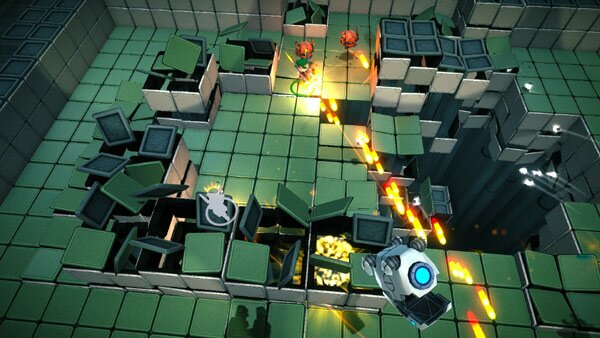Game Info
GAME NAME: Assault Android Cactus
DEVELOPER(S): Witch Beam
PUBLISHER(S): Witch Beam
PLATFORM(S): PS4
GENRE(S): Twin-Stick Shooter, Action
RELEASE DATE(S): March 8, 2016
Assault Android Cactus from Australian indie Witch Beam drops you, the eponymous android Cactus (the green hair, get it?) onto container ship Genki Star to see just what the hell is going on here. A twin-stick shooter, AAC has all the pieces in place to give a fun, manic experience every time you fire it up, alone or with couch friends.

The action of AAC is quite good, due to a meshing of several systems together. Any twin-stick can have you move and shoot, but AAC’s stages often change their topography, creating and removing cover spots and enemy entryways as the level develops. Your favorite hiding spot, for instance, can disappear into a chute in the floor for evil robots to crawl (or climb or fly) out of. Some later stages have this running near-constantly, creating a perpetually shifting landscape. Stay on your toes; this isn’t a game you can take your eye off. The shifting floors and stages create and remove cover and hiding spots, meaning you’ll have to be pretty dynamic with your footwork. Weapon power-ups, speed boosts, and money will be dropping frequently as well, so there’s also that to track. While all this is going on, you’re going to get hit and take damage – but AAC has you covered there too. Although you can only sustain a few hits, your android can self-revive for as long as you have battery power. Battery chargers drop at intervals in every stage, so they function almost as a timer. Spend too much time reviving yourself, and you can’t kill enough enemies to generate a charger before your battery dies. In most stages, this level of forgiveness is quite helpful – although boss battles are a different story.
Those bosses. There are difficulty spikes, and then there’s fighting these guys. It generally becomes an issue of damage over time and hoping a battery will drop in time before you power down and lose the battle. But having to self-revive so many times towards the end of your battery life has such a terrible cascade effect that if you go down towards the end of the fight, you’re probably done for. These difficult battles thankfully only occur a few times, but they still mar an otherwise excellent game.
However, you could always fire up a second controller and have a friend or three help out. Local co-op for up to four is supported, which increases enemy count and skill, but is greatly offset by having someone else there. And with the game as easy as it is to pick up and play, you can get just about anyone to help out. While there’s no online co-op gameplay, AAC does have a leaderboard and score tracking for your elusive S+ rating, so you can still show your skills asynchronously. AAC also have purchasable mutators via ingame credits, which add a fun variety to the game. Need more challenge? Make the enemies as tough as they are during a multiplayer match in your single-player game. Want to experience the game from a completely different viewpoint? Play this twin-stick bullet hell monster IN FIRST PERSON. It’s very fast and a bit disorienting, but definitely a new take on this style of gameplay.

Probably the best part about AAC is the sky-high production values that make up the graphics and audio. The game looks great, with sharp detail and a very fun, interesting level composition. It’s one part space station, one part crazy android disco with tons of enemies to take down. Some stages have the lights off, requiring a flashlight (don’t worry DOOM detractors, you can use it while shooting). But even in these stages, enemies give off a dim glow, so you’re not just spinning until you find what you’re supposed to be shooting at. Power-ups have great visual trinkets that attach to your android, and – this is important, so take note – there is no slowdown on even the most hellish of bullet hell stages. However, all the bullets, robot gibs, power-ups, flashing lights, enemies, and sometimes crazy shifting floor patterns can make you lose track of approaching bullets so in the really frenzied stages extra attention needs to be paid to stay alive. But with the damage and revive system, it’s not a huge issue, so take it with a grain of salt.
The audio of AAC is right on par with the visuals. Excellent music that can use an aforementioned mutator to slow down or crank up as the action kicks off really ties the whole experience together. Additionally, aside from short in-stage text breaks, AAC has full voice acting for all the characters. They’re all voiced well too, especially Cactus herself, who sounds like she’s having a great time at this robot-shoot thing. It’s a fun, unexpected bonus from a manic twin-sticker to have reasonably cheerful, excited protagonists with fun personalities having a great time.
The Recommendation
If you’re a twin-stick fan, this game should definitely be in your collection. The variety of characters, the overall presentation, the mutators, the collection stuff – this all seems like it came from a game with a much bigger footprint. AAC is a fantastic entry into the twin-stick genre with lots of replayability and a super-slick aesthetic.



























